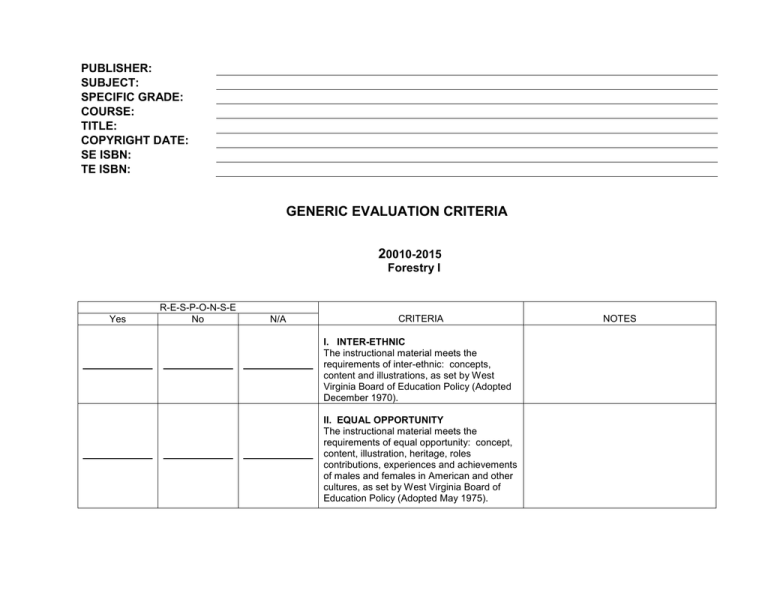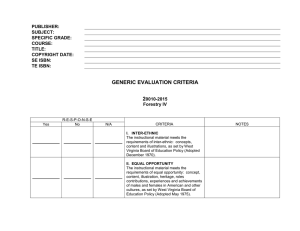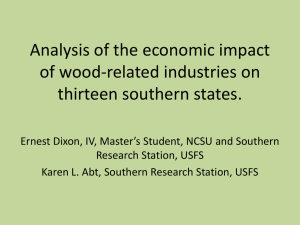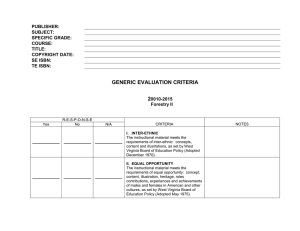GENERIC EVALUATION CRITERIA 2 PUBLISHER:
advertisement

PUBLISHER: SUBJECT: SPECIFIC GRADE: COURSE: TITLE: COPYRIGHT DATE: SE ISBN: TE ISBN: GENERIC EVALUATION CRITERIA 20010-2015 Forestry I Yes R-E-S-P-O-N-S-E No N/A CRITERIA I. INTER-ETHNIC The instructional material meets the requirements of inter-ethnic: concepts, content and illustrations, as set by West Virginia Board of Education Policy (Adopted December 1970). II. EQUAL OPPORTUNITY The instructional material meets the requirements of equal opportunity: concept, content, illustration, heritage, roles contributions, experiences and achievements of males and females in American and other cultures, as set by West Virginia Board of Education Policy (Adopted May 1975). NOTES INSTRUCTIONAL MATERIALS ADOPTION: 21st CENTURY LEARNING EVALUATION CRITERIA 20010-2015 Forestry I Forestry I (Vendor/Publisher) SPECIFIC LOCATION OF CONTENT WITHIN PRODUCT (IMR Committee) Responses I=In-depth A=Adequate M=Minimal N=Nonexistent I A M N In addition to alignment of Content Standards and Objectives (CSOs), materials must also clearly connect to Learning for the 21st Century which includes opportunities for students to develop A. Learning Skills Thinking and Problem-Solving Skills. Information and Communication Skills. Interpersonal and Self-Direction Skills and use these 21 Century Tools B. 21st Century Tools Problem-solving tools (such as spreadsheets, decision support, design tools) Communication, information processing and research tools (such as word processing, e-mail, groupware, presentation, Web development, Internet search tools) Personal development and productivity tools (such as e-learning, time management/calendar, collaboration tools) INSTRUCTIONAL MATERIALS ADOPTION: 21st Century Learning EVALUATION CRITERIA The general evaluation criteria apply to each grade level and are to be evaluated for each grade level unless otherwise specified. These criteria consist of information critical to the development of all grade levels. In reading the general evaluation criteria and subsequent specific grade level criteria, e.g. means “examples of” and i.e. means that “each of” those items must be addressed. Eighty percent of the combined general and specific criteria must be met with I (In-depth) or A (Adequate) in order to be recommended. 20010-2015 Forestry I (Vendor/Publisher) SPECIFIC LOCATION OF CONTENT WITHIN PRODUCT (IMR Committee) Responses I=In-depth A=Adequate M=Minimal N=Nonexistent I A M For student mastery of content standards and objectives, the instructional materials will provide students with the opportunity to 4. Multimedia 1. offer appropriate multimedia (e.g., software, audio, visual, internet access) materials. 2. provide a website which provides links to relevant sites as well as lesson plans, student activities and parent resources. 3. integrate technology into the curriculum. N B. Scientifically-Based Research Strategies 1. provide explicit instructional strategies to present varied teaching models including but not limited to webbing, mapping, Venn diagrams and inverted pyramids. 2. promote writing skills and study techniques . 3. present varied teaching models with emphasis on differentiated instruction in content, process, and product. C. Critical Thinking 1. emphasize questioning models to promote higher order thinking skills based on Bloom’s Taxonomy. 2. promote student-generated responses. D. Life Skills 1. address life skills (e.g., health related concepts, goal setting, application to career oriented goals, reference tools, and researching). 2. address habits of mind activities (e.g., literacy skills, interpersonal communications, problem solving, and self-directional skills). E. Classroom Management 1. include opportunities for large group, small group, and independent learning. 2. provide classroom management suggestions. 3. provide suggestions for differentiated instruction (e.g., practice activities, learning stations, assessment, lesson plans). F. Instructional Materials 1. address varied learning styles and multiple intelligences of students by including models. 2. provide extensive and varied opportunities to practice skills. 3. provide intervention, practice, and enrichment materials. 4. continue skill or strategy instruction across several instructional sessions to expand the applicability and utility of the skill or strategy. 5. connect previously taught skills and strategies with new content and text. 6. cumulatively build a repertoire of multiple strategies that are introduced, applied, and integrated throughout the course of study. G. Assessment 1. provide opportunities for assessment based on performance-based measures, open-ended questioning, portfolio evaluation, rubrics, and multimedia simulations. 2. provide on-going progress monitoring. 3. provide rubric-based differentiated assessment. INSTRUCTIONAL MATERIALS ADOPTION: CONTENT SPECIFIC EVALUATION CRITERIA 20010-2015 Forestry I This area of study is designed to provide students with basic knowledge and skills in forestry and related occupations. Major instructional concepts included in this area of study are: safety principles in forestry, tree identification, forest protection, basic forest measurement, and silvicultural practices. Students will utilize problemsolving techniques and participate in laboratory activities to develop an understanding of course concepts. Safety instruction is integrated into all activities. Teachers should provide each student with real world learning opportunities and instruction related to selection, development, and maintenance of individual Supervised Agricultural Experience (SAE) programs. Students are encouraged to become active members of FFA, the national youth organization for those enrolled in agricultural education. FFA is an integral component of the program and provides curricular opportunities that enhance student achievement. Teachers should utilize relevant FFA activities to support experiential learning. The West Virginia Standards for 21st Century Learning include the following components: 21st Century Content Standards and 21st Century Learning Skills and Technology Tools. All West Virginia teachers are responsible for classroom instruction that integrates learning skills, technology tools, and content standards and objectives. Standard 1: Nature of Forest Industries Students will: demonstrate an understanding of the scope of the forest industries. demonstrate the ability to use the inquiry process to solve problems. Standard 2: Content of Studies in Forest Industries Students will: demonstrate knowledge, understanding, and applications of facts, concepts, principles, theories, and models as delineated in the objectives. relate the principles contained in the sciences, economics, mathematics, and language arts to forest industries. Standard 3: Application of Knowledge and Skills Acquired Through Studies of Forestry Students will apply the principles of the sciences, economics, mathematics, and language arts to forest industries. analyze information and situations to select the best means of performing tasks associated with forest industries. demonstrate an ability to utilize technology to perform tasks associated with studies in forestry. evaluate forest products and processes and defend decisions related to such. engage in work-based learning through Supervised Agricultural Experience (SAE) programs. Standard 4: Participation in the student organization Students will participate in a local student organization. (Vendor/Publisher) SPECIFIC LOCATION OF CONTENT WITHIN PRODUCT (IMR Committee) Responses I=In-depth A=Adequate M=Minimal N=Nonexistent I A M For student mastery of content standards and objectives, the instructional materials will provide students with the opportunity to A. Nature of the Forestry Industries 1. demonstrate an awareness of employment opportunities in forestry based on educational level. 2. distinguish between state, national, and private forest employment opportunities. B. Content of Studies in Forest Industries 1. distinguish specific forest ownership groups. 2. diagram forest and biome regions of the U.S. 3. compare and contrast professional forestry employment and technical forestry employment. 4. apply identification skills to the following trees: red oak, white oak, black oak, chestnut oak, scarlet oak, sugar maple, red maple, hickory, white pine, red spruce, hemlock, black cherry, black locust, yellow poplar, cucumber, Virginia pine, white ash, and basswood. 5. examine internal and external parts of a tree. N 6. explain factors affecting tree growth. 7. evaluate the site, growing space, crown classes, site index, tolerance, and succession stages of an actual forest stand. 8. determine proper tool use for a specific forest practice or operation. 9. use appropriate units of measurement (acre, rod, chain, mile). C. Application of Knowledge and Skills Acquired Through Studies of Forestry 1. maintain a safe working environment by identifying potential hazards. 2. collect and identify major WV tree species using leaves and twigs. 3. use increment borer to determine age and growth rate of trees. 4. select and mark trees for thinning using D + 6 rule. 5. apply identification skills to the following tools. (WV CDE Tools List). 6. utilize surveying instruments. 7. experiment with pacing to determine linear distance. 8. determine a bearing using a hand compass. 9. calculate board foot volume of standing timber using Doyle and International ¼ inch rules. 10. measure standing trees of DBH and height in 16 ft. logs. 11. utilize topographical and soil survey maps in forest management.






